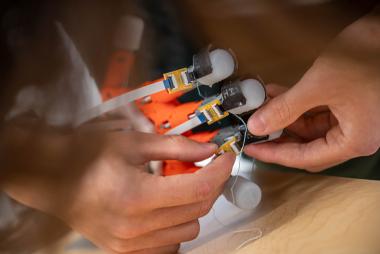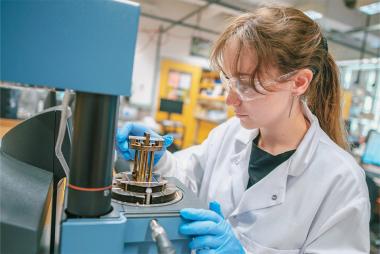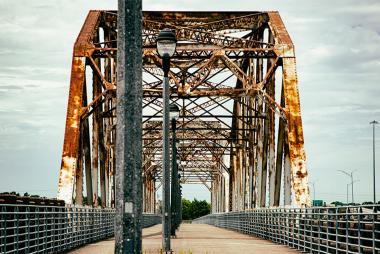Preparing for the Big One: UBC Engineering shares lessons from Türkiye’s earthquakes
October 20, 2023
The deadly earthquakes that struck Türkiye and Syria in February 2023 resulted in a catastrophic loss of life, injured many more, and left1.5 million people homelessas buildings collapsed or became unsafe to use.
UBC Engineering led a team of researchers, technical and industry experts on a visit to Türkiye in June to inspect damaged infrastructure and learn about the resilience of different buildings. The team shared insights from their visit at atechnical seminar last week公元前,目标是更好的通知earthquake preparedness, response and recovery practices.
Comparing seismology and building codes in Türkiye and BC
Located in one of the world’s most seismically active regions, Türkiye has long prepared for destructive earthquakes. Of this year’s quakes, Dr. Alemdar Bayraktar, a visiting professor atUBC’s Department of Civil Engineeringsaid, “The long duration of ground shaking and underestimation of the seismic demands during the construction and design process contributed to the extensive damage and collapse of multiple buildings.”
Liquefaction-induced ground and structural failures were also widespread in some coastal and lakeside cities, noted Dr. Keshab Sharma, a geotechnical engineer atBGC Engineering.“Several locations in Western Canada, including Vancouver, have all the parameters that trigger liquefaction,” he warned.
Dr. Tony Yang, a UBC civil engineering professor and seminar host, spoke about Türkiye’s experiences with earthquakes every 15 to 20 years and how the country regularly updates its building code. He noted that buildings that failed in February’s quakes were mostly designed to older building codes. The most recent code (2018) is, however, “really robust,” shares many similarities with Canada’s national building code, and even goes a step farther in some areas (such as procedures to assess and retrofit existing buildings).
“I am very proud of my Turkish colleagues. They are not afraid of using novel technology such as base isolation dampers. All hospitals in high-seismic zones are required to be base-isolated,” said Yang.
Residential buildings, schools and hospitals in earthquakes

了解西文sential buildings withstand earthquakes is crucial to helping people survive.
Ausencostructural engineer-in-training Dr. Jeffrey Salmon expanded on how base-isolated health-care facilities far outperformed fixed-base structures during high-intensity ground shaking; base-isolated hospitals remained fully operational whereas most fixed-base facilities had to close.
He recounted a story from the director of one base-isolated hospital where a surgery continued during and after the earthquake with no interruption. “To me, it’s an anecdote that highlights the power of base isolation and allowing operations of these facilities.”
UBC adjunct professor of civil engineeringDr. Svetlana Brzev, touched on how multi-family, mid- to high-rise residential buildings made of reinforced concrete were most affected.
“Some buildings that looked by careful inspection to have very little structural damage in fact had extensive non-structural damage and had to be vacated,” she said. She identified imprecise definitions in former building codes, configuration irregularities, and a substandard quality of materials and construction as additional factors leading to the loss of these residences.
Schools generally fared better due to robust design, stronger code enforcement and higher quality of materials, explained Dr. Bishnu Pandey, an engineering instructor at theBritish Columbia Institute of Technology.Nonetheless, almost 2,000 school buildings were completely damaged, and many more suffered partial or minor damage. Pandey commented on how almost one third of affected households did not send their children to school, in some cases “because they are so scared” of schools with visible damage, even when damage was minor.

Allison Chen, practice advisor atEngineers and Geoscientists British Columbia, spoke on the similarities between Türkiye and BC’s approach to schools, emphasizing the higher requirements for schools in BC’s building code, as well as the Ministry of Education’sSeismic Mitigation Program.她证实,“我们要把课learned from Türkiye and update these guidelines” for seismic retrofit of schools, noting liquefaction, non-structural components and post-earthquake evaluation as key discussion topics.
Emergency response and recovery
Speaking again later in the seminar, Salmon detailed recovery and response efforts in the first two months after the earthquakes, including the importance of a rapid building assessment to calculate if buildings were safe enough for people to return to, or if temporary tents would need to be deployed.
Dr. Şerife Özata, a research assistant at Ahi Evran University, was a volunteer for the general damage assessment process and explained how the process works in crisis situations. The aim is to quickly identify what buildings can and cannot be used, and which need to be prioritized for demolishing to prevent further risk to life and safety. “In one month, approximately 6.8 million buildings and detached units were assessed” using this method, she said.
Salmon and Chen also spoke about the psychological impact of the earthquakes on survivors afraid to enter buildings, the challenge of quickly building and transitioning people to temporary prefabricated homes while the rebuilding process continues, and the use of purpose-built community centres to help people socialize and rebuild connections.
“One key takeaway is just how important it is to be prepared to have your networks in place and be able to mobilize immediately... to get that response and recovery process going right away,” said Chen.
She emphasized the role that different government agencies in Türkiye have in disaster preparedness, holding earthquake drills, and having clear search and rescue plans.
“The key things for success in any disaster response plan are: for everyone involved to know what their responsibilities are, to own the plan, to really feel like they’re involved with it. It’s important that they do their job. That they communicate with each other, and that all actions are done on time and in accordance with the plan.”
Earthquakes are a reality in BC, but not to the same degree of public consciousness as in Türkiye. A severe earthquake in BC is inevitable — it is only a matter of when.
Before that happens, everyone in BC — engineers, policymakers and individuals — has a part to play in ensuring that people and buildings are prepared for and ready to respond to the Big One.

Missed the live event or would like to view it again? A recording is now available onUBC Engineering’s YouTube channel.
View the event'sslide presentation.



